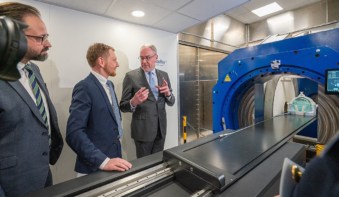

Advancements in biofabrication have enabled the translation of simple 2D cell models to complex multicellular 3D models that could be utilized in tissue engineering, for drug testing in vitro or even for transplantation. Biofabrication for tissue engineering and regenerative medicine applications comprises the use of cells and biomaterials as building blocks to build a layered tissue construct. A limitation of tissues produced in this way has been a lack of vascularization, as this requires precise spatial distribution of vasculature within a 3D model. This vascularization could be introduced through 3D bioprinting, where precise deposition of endothelial cells within a 3D construct could rectify the issue.
A further complication to introducing vascularization into a 3D bioprinted construct comes from selecting the correct biomaterial, which must have bioprintable properties (bioink) whilst allowing for cell-cell and cell-bioink interactions. This issue has been addressed by researchers from the University of Freiburg, who have assessed a panel of bioinks for their suitability as a 3D culture material of endothelial cells, which form the blood vessels of the circulatory system (J. Biomed. Mater. Res. Part A doi: 10.1002/jbm.a.36291).
Hydrogel-based bioinks
For this study, the group tested bioinks based on hydrogels – water rich saturated polymers – from either natural or synthetic sources. They also evaluated the printability of the hydrogels through an inkjet based 3D bioprinting system. From the hydrogels tested, they found that fibrin and collagen were best for the range of characteristics tested; with good bioprinting characteristics and enabling the formation of blood vessels with capillary-like cords developing from the cells in these gels.
The researchers observed issues with the other gels, such as a lack of inkjet-based printability or an inability to be cultured with cells. For example, the synthetically sourced pluronic acid hydrogel and naturally sourced alginate/gelatin blend hydrogel were unstable in the medium required for cell sustenance, resulting in rapid degradation and an inability to form a sustained solid 3D structure.
Future tests
The panel-based hydrogel screening approach used in this study proved useful in establishing the key functional characteristics for inkjet bioinks in vascularization applications. There are also many other hydrogels and bioinks that have not been tested in this research. The authors note that the functional outputs recorded and protocols used to assess the suitability of these hydrogels could easily be translated to assess other hydrogels for similar applications.
Translational applications
Further research could utilize these results to build a tissue-specific panel of vascularization bioinks. For example, the development of brain-specific endothelial cells through stem cell differentiation could establish materials suitable for modelling and transplantation of brain tissue.
The advantages of using stem cells are that they can be extracted from a skin biopsy as adult stem cells and reprogrammed to have pluripotency (capability to differentiate into multiple lineage cell types), referred to as induced pluripotent stem cells (iPSCs). Studies of such iPSCs may result in more effective treatment of diseases that affect multicellular tissues and organs, adding complexity and stratified screening strategies to medical research.



